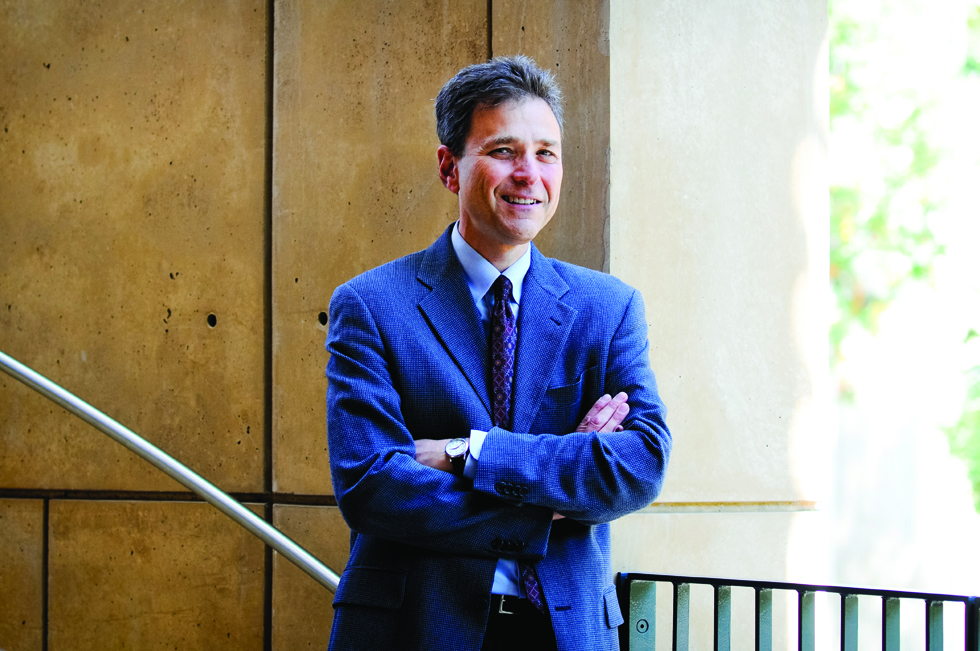David Sklansky: Rethinking Privacy and the Fourth Amendment

In an era when headlines frequently trumpet the latest episode of governmental monitoring of electronic communications, it’s tempting to think about privacy predominantly as it relates to the unwanted exposure of personal data.
But according to David Sklansky, Stanley Morrison Professor of Law, whose interest in criminal justice issues dates back to his time as a federal prosecutor, that view of privacy is much too narrow, particularly when considering Fourth Amendment protections against unreasonable searches and seizures.
“For a while now,” says Sklansky, “I’ve felt that both courts and scholars have gotten off track in focusing excessively on informational privacy. That’s very important, but privacy is not just about controlling information flows. It’s about much more.”
According to Sklansky, privacy has to include the idea of an opportunity for retreat or sanctuary—a refuge from society. Moreover, he says, “privacy isn’t something we have; it’s a set of relations based on standards of civility that define us as a society.”
To refocus the discussion, Sklansky has written two articles, the first, “Too Much Information: How Not to Think about Privacy and the Fourth Amendment,” and a follow-up piece, “Two More Ways Not to Think about Privacy and the Fourth Amendment.”
In the first article, Sklansky observes that although privacy has long been thought to be at the core of the Fourth Amendment’s protections, its current connection has become unclear. He catalogs a number of doctrinal developments in Fourth Amendment jurisprudence that have diminished privacy’s central role. A key turn, he suggests, came in the 1970s when scholars and courts, reacting to the expansion of privacy protections in cases like Griswold v. Connecticut, Eisenstadt v. Baird, and Roe v. Wade, sought to narrow the concept. They succeeded so well, Sklansky says, that defining privacy solely in terms of control over information flows has become almost second nature. That’s partly, he acknowledges, because this definition focuses privacy protection on a set of threats widely understood to be particularly pressing in the Digital Age.
Nonetheless, Sklansky rejects such a cramped definition and instead reimagines privacy broadly.
Mining the history of privacy, Sklansky explains that for more than a century the language used to define privacy included “sphere,” “domain,” and “realm,” as well as the metaphor of “stripping naked” to describe privacy invasions.
“If we ignore these aspects of privacy—sovereign space and enclothement—we fail to account for the really serious Fourth Amendment violations that can be caused by strip searches, the use of informants, and intrusions into home and family life,” Sklansky says.
He also worries that if we exclude these types of intrusions from the definition of privacy, and thus from Fourth Amendment protection, we risk losing sight of the way that privacy violations can train the perpetrators in habits of dehumanization and depersonalization.
“That’s arguably what happened during the infamous Stanford Prison Experiment,” he observes, “where students who were assigned to be guards gradually were transformed into perpetrators of abuse. Privacy violations, particularly strip searches that they were instructed to conduct, seem to have played a significant role in their transformation.”
Similarly, the behavior of the Abu Ghraib guards provides another chilling example of the effect that privacy violations potentially can have on those who perpetrate them. Sklansky says that “it’s not surprising that the torture of prisoners was accompanied by rampant and intentionally degrading strip searches and by interrogations conducted while prisoners were forced to remain naked.” He also notes that military investigators later found that in some cases the “ ‘tone and environment’ surrounding these practices were ‘the causative factor that set the stage’ for worse abuses.”
Sklansky concludes that thinking about privacy as a kind of refuge or sanctuary does not necessarily get us all the way to the correct definition for Fourth Amendment purposes, but it gets us on the right track. “It’s at least a partial way of figuring out where society has an interest in keeping government searches and seizures at bay.”
In his follow-up essay, Sklansky challenges two increasingly common ideas: that the political branches are best suited to developing privacy protections and that the Fourth Amendment’s privacy protections can be best understood by reference to the past.
“While it’s true that legislative hearings can take a broader and more systemic view, judicial hearings are adversarial, assuring at least some representation by both sides. Legislative hearings on privacy issues in criminal investigations can easily be dominated by law enforcement interests,” Sklansky says.
Further, Sklansky observes, legislatures are “notoriously sluggish,” and Congress has often been “unwilling or unable to correct legislation that is flawed or outdated”—or to fill glaring gaps in the constitutional restrictions the Supreme Court has crafted.
Sklansky also questions attempts by scholars and courts to define the privacy protected by the Fourth Amendment by reference to the past.
“Privacy is multidimensional, and it is unevenly distributed,” he explains. “Accordingly, asking whether there is more or less privacy today than in 1791 is close to meaningless without specifying whose privacy and what kind.”
These questions can’t be answered without some idea about why privacy is valued and why it is constitutionally protected. “For Fourth Amendment law,” he says, “the more specific question is how infringements on privacy can make a search or seizure ‘unreasonable.’ To decide that, we need a sense of what privacy means and why it matters.” SL
